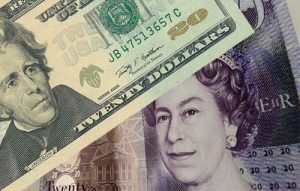 Yesterday’s trade saw GBP/USD within the range of 1.4721-1.4845. The pair closed at 1.4745, losing 0.57% on a daily basis.
Yesterday’s trade saw GBP/USD within the range of 1.4721-1.4845. The pair closed at 1.4745, losing 0.57% on a daily basis.
At 8:44 GMT today GBP/USD was down 0.01% for the day to trade at 1.4747. The pair touched a daily low at 1.4727 at 8:19 GMT.
Fundamentals
United Kingdom
Bank of England Minutes
Released two weeks after the policy meeting itself, the minutes provide a full account of the policy discussion, including differences of view. They also record the votes of the individual members of the Monetary Policy Committee (MPC). On March 5th all 9 members of the Committee probably voted in favor of keeping the benchmark interest rate unchanged. In addition, all members of the Committee probably voted to keep the stock of purchased assets financed by the issuance of central bank reserves unchanged at GBP 375 billion. In case the central bank demonstrates a hawkish view in regard to inflation pressure and overall economic activity in the UK, this heightens the probability of an interest rate hike, which has a positive effect on the pound. A dovish view, on the other hand, will have the opposite effect.
Despite that market expectations point to a rate hike this year, inflation remains well below the 2% objective and policy makers believe it is more likely than not it will slip below 0 in the coming months. In January annual consumer inflation in the UK was registered at -0.3%, or the lowest on record.
Claimant Count Change, ILO Unemployment Rate
The number of jobless claims in the United Kingdom probably dropped by 30 000 in February, marking the 29th consecutive month of declines, according to expectations, following another drop by 38 600 in January. The latter has been the most considerable decrease in claims since June 2014, when their number fell by 39 500. At the same time, the claimant count rate, which represents the percentage change of jobless claims compared to the entire work force, probably fell to 2.4% in February from 2.5% during the previous month. If so, this would be the lowest claimant count rate in at least 7 years.
The rate of unemployment in the UK, estimated in accordance with ILO (International Labour Organization) standards, probably fell to 5.6% during the three months to January compared to the same period a year ago. If so, this would be the lowest rate since July 2008, when unemployment level was reported at 5.5%. In the period to December 2014 the unemployment rate was registered at 5.7%.
During the period October-December 2014 there were 30.90 million people in employment, or an increase by 103 000 compared to the period July-September and also 608 000 more compared to October-December a year earlier. During the same period 1.86 million people were unemployed, or 97 000 fewer than in the period July to September and 486 000 fewer compared to October-December 2013.
In October to December there were 9.05 million people aged between 16 and 64, who were out of work and not seeking or available for employment, according to data by the Office for National Statistics (ONS). This represented an increase by 22 000 compared to July-September 2014 and by 6 000 compared to October-December 2013.
The rate of unemployment refers to the percentage of economically active people, who are currently unemployed. According to the ILO approach, people who are considered as unemployed are either: 1) out of work, but are actively searching for employment, or 2) out of work and are waiting to be hired again during the next two weeks.
The ILO Unemployment Rate is based on a monthly survey, known as the Labour Force Survey in the United Kingdom, with approximately 40 000 individuals being interviewed every month. This indicator reflects overall economic state in the country, as there is a strong correlation between consumer spending levels and labor market conditions. Low rates of unemployment are accompanied by higher spending, which causes a favorable effect on corporate profits and also accelerates overall growth. In case the rate of unemployment met expectations or fell even further, this would certainly have a bullish effect on the sterling. The official report by the ONS is due out at 9:30 GMT.
United States
Federal Reserve decision on policy
The Federal Open Market Committee (FOMC) will probably keep its benchmark interest rate unchanged within the range 0%-0.25% for a 49th consecutive meeting, after the end of the Quantitative Easing cycle, according to the median forecast by experts.
During her testimony before the Senate Banking Committee last month Federal Reserve Chair Janet Yellen said that the bank was ready to consider interest rate hikes on a meeting by meeting basis, in case US economic conditions continued improving. According to extracts from Yellens Semiannual Monetary Policy Report before the Congress: “It continues to be the FOMCs assessment that even after employment and inflation are near levels consistent with our dual mandate, economic conditions may, for some time, warrant keeping the federal funds rate below levels the Committee views as normal in the longer run. It is possible, for example, that it may be necessary for the federal funds rate to run temporarily below its normal longer-run level because the residual effects of the financial crisis may continue to weigh on economic activity. As such factors continue to dissipate, we would expect the federal funds rate to move toward its longer-run normal level. In response to unforeseen developments, the Committee will adjust the target range for the federal funds rate to best promote the achievement of maximum employment and 2 percent inflation.”
“The FOMC intends to adjust the stance of monetary policy during normalization primarily by changing its target range for the federal funds rate and not by actively managing the Federal Reserves balance sheet. The Committee is confident that it has the tools it needs to raise short-term interest rates when it becomes appropriate to do so and to maintain reasonable control of the level of short-term interest rates as policy continues to firm thereafter, even though the level of reserves held by depository institutions is likely to diminish only gradually.”
“In sum, since the July 2014 Monetary Policy Report, there has been important progress toward the FOMCs objective of maximum employment. However, despite this improvement, too many Americans remain unemployed or underemployed, wage growth is still sluggish, and inflation remains well below our longer-run objective.”
The minutes from Feds policy meeting held on January 27th-28th revealed policy makers were concerned that a sooner increase in borrowing costs could hinder economic recovery. According to an extract from the January minutes: “Participants discussed the tradeoffs between the risks that would be associated with departing from the effective lower bound later and those that would be associated with departing earlier. Several participants noted that a late departure could result in the stance of monetary policy becoming excessively accommodative, leading to undesirably high inflation. It was also suggested that maintaining the federal funds rate at its effective lower bound for an extended period or raising it rapidly, if that proved necessary, could adversely affect financial stability. Some participants were concerned that a decision to delay the commencement of tightening could be perceived as indicating that an overly accommodative policy is likely to prevail during the firming phase. In connection with the risks associated with an early start to policy normalization, many participants observed that a premature increase in rates might damp the apparent solid recovery in real activity and labor market conditions, undermining progress toward the Committees objectives of maximum employment and 2 percent inflation.”
The FOMC will announce its official decision on policy at 18:00 GMT. A rate hike would surely boost demand for the US dollar.
At 18:30 GMT Janet Yellen is scheduled to take a statement at a press conference regarding monetary policy stance. Her tone will certainly influence greenbacks volatility, as a more hawkish tone will provide support, while a more dovish tone will lead to a sell-off.
Pivot Points
According to Binary Tribune’s daily analysis, the central pivot point for the pair is at 1.4770. In case GBP/USD manages to breach the first resistance level at 1.4820, it will probably continue up to test 1.4894. In case the second key resistance is broken, the pair will probably attempt to advance to 1.4944.
If GBP/USD manages to breach the first key support at 1.4696, it will probably continue to slide and test 1.4646. With this second key support broken, the movement to the downside will probably continue to 1.4572.
The mid-Pivot levels for today are as follows: M1 – 1.4609, M2 – 1.4671, M3 – 1.4733, M4 – 1.4795, M5 – 1.4857, M6 – 1.4919.
In weekly terms, the central pivot point is at 1.4859. The three key resistance levels are as follows: R1 – 1.5022, R2 – 1.5299, R3 – 1.5462. The three key support levels are: S1 – 1.4582, S2 – 1.4419, S3 – 1.4142.





